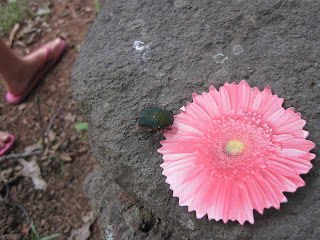Hermaphrodite- 4:12
p.m., August 1st, in my yard. An organism, plant or animal,
having both male and female reproductive organs, that is capable of producing
both male and female gametes. A mushroom represents this because it’s a fungus,
which has both male and female reproductive organs.
AP Bio Project
Monday, August 27, 2012
Nymph- Termite
Nymph- 4:05 p.m., August
1st, in my yard. The young of an insect that undergoes incomplete
metamorphosis, an immature insect. These young termites are nymphs because they
are juvenile and have not yet morphed into the adult phase.
Chitin- Beetle Exoskeleton
Chitin-
4:25 p.m., August 1st, in my yard. Chitin is tough but flexible
exoskeleton or arthropods. The shell of a beetle represents Chitin because a
beetle is an arthropod and it’s shell is a tough outer layer.
Gametophyte- Moss
Gametophyte- 4;28
p.m., August 1st, in my yard. In plants and photosynthetic protists
with an alternation of generations the haploid phase, that produces the
gametes. Moss is a gametophyte because it is a photosynthetic protist.
Vitamin E- Natural source- Avocado
Naturally Derived
Source of Vitamin E- 8:45 p.m., August 21st, my kitchen. Vitamin E includes seeds, nuts, and vegetable oils. An avocado is a vegetable and
contains fatty oils.
Carotenoid- Orange Pepper
Carotenoid- 8:00
p.m., August 21st, in my garden. A yellow, orange, or red lipid
pigment commonly found as an accessory pigment in photosynthesis in fungi. An
orange pepper has pigment and is a plant
Taiga Plant- Pine Tree
Taiga Plant- 7:45
a.m., August 21st, in my yard. Plants that live in the ecosystem
known as a taiga. Taigas are forests mainly in sub-arctic regions. Taiga plants
mainly include coniferous trees. A pine tree is a taiga plant because it’s
coniferous.
Subscribe to:
Comments (Atom)






